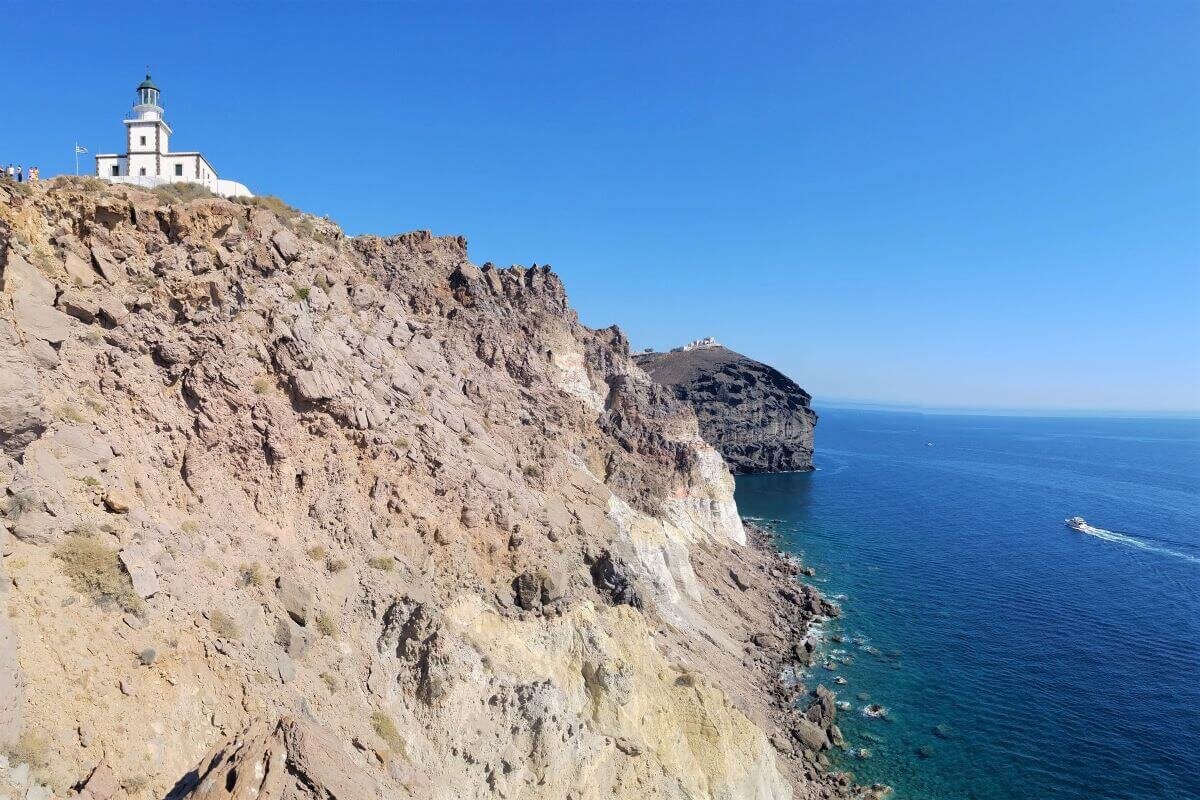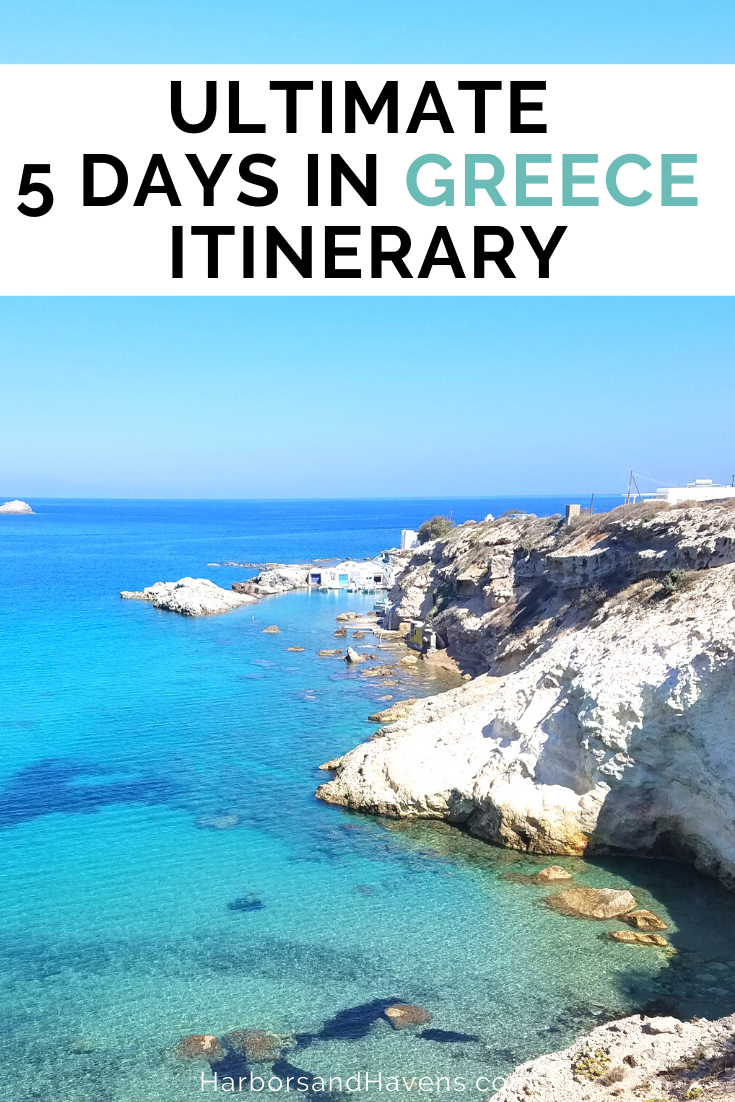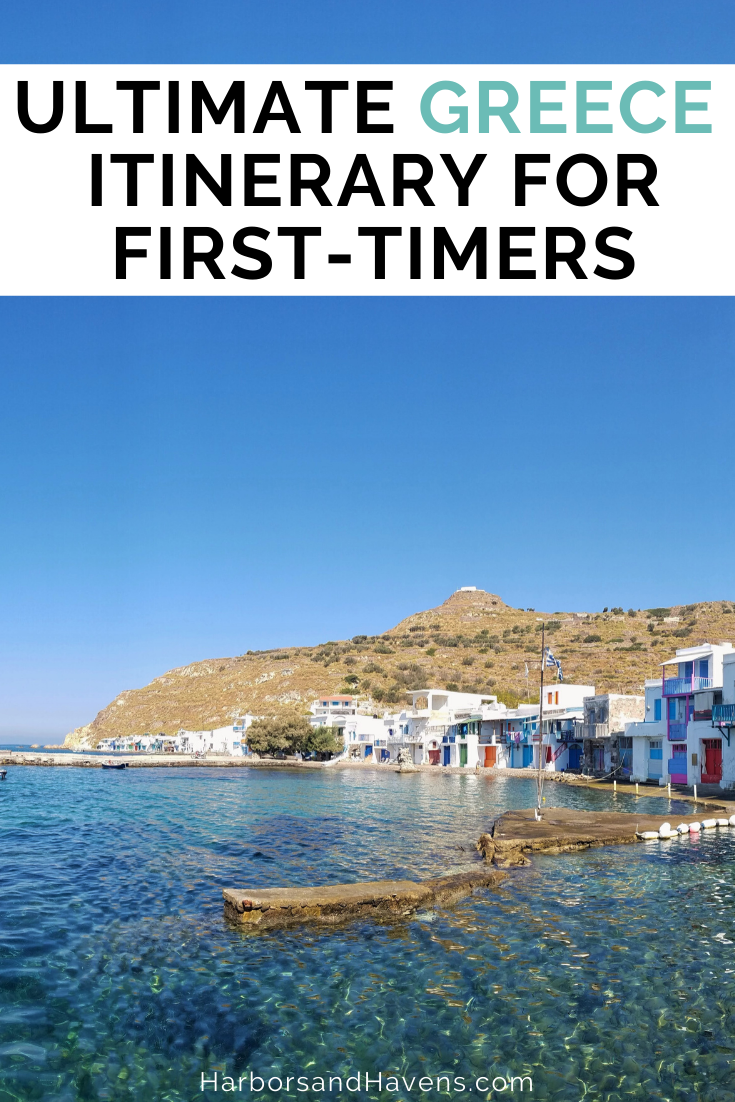The Best 5 Days in Greece Itinerary for First-Timers
This 5 days in Greece itinerary includes Athens and the Greek islands for a vacation that combines history and culture with breathtaking seaside scenes.
Ancient ruins, picture-perfect hillside villages, spectacular beaches spilling into the cyan sea — it’s all in store on this 5 day Greece itinerary.
You’ll start with a couple of nights in Athens, the storied capital of Greece with a legacy preserved in its timeworn temples and citadels. Located in the southern part of the country, it’s also the perfect launching point for the Greek islands, the next destination on this 5 day Greece itinerary.
I’ve included two island suggestions below that might appeal to different types of travelers. Santorini, a bucket-list buster, is all about the cliffside views, sparkling villa pools, and Instagram-perfect villages that bring hoards of crowds in summer. You can mix things up a bit, though, with boat rides, hiking and some distinct black and red beaches.
Milos, on the other hand, feels much quieter and more authentic than Santorini, thanks to limited cruise ship visits. It’s just as stunning though, with cute fishing hamlets, white stucco towns, and some of the prettiest coastline I’ve ever seen. Among the hoards of Milos beaches are easily accessible sandy ones with tourist amenities and natural rugged landscapes that reward adventurers with a private slice of paradise.
Keep reading for a Greece 5 day itinerary, or if you have a little longer to stay, consider these 7 days in Greece and 10 days in Greece vacation plans to pack in more island hopping.
5 Day Greece Itinerary
Days 1-2: Athens
Days 3-5: Santorini or Milos
Greece Itinerary: 5 Days in Athens and the Greek Islands
Use this 5 days in Greece itinerary to plan out what to see and do in Athens, Santorini and Milos. I’ve included a blend of historic ruins, charming villages and sun-soaked beaches.
Day 1-2 — Athens
One of the oldest cities in the world, Athens is jam-packed with ancient ruins of temples, arenas and markets. With just two days in Athens on a five day Greece itinerary, you can see most of the top historical attractions with time for a couple of museums or some shopping as well.
Most of the ruins listed below are included in a combo pass sold at the accompanying ticket offices. This typically costs less than individual entry during the summer high season.
If your ferry or flight for the islands leaves on day two, you may want to follow our one day in Athens itinerary instead. The tips section at the bottom includes info on traveling around Greece.
Athens Ruins
Perched on a flat hilltop in downtown Athens, the 5th-century BC Acropolis was a hub of ancient Greek art and philosophy and contains such famous landmarks as the Parthenon, Temple of Athena Nike and Theatre of Dionysus. As perhaps the most famous attraction in the city, the citadel is typically crowded, so visit first thing in the morning or late in the afternoon for the best experience.
Just below the Acropolis and outside the ticketed area, Areopagus Hill hosted an ancient court and meeting place and is mentioned in the Bible book of Acts. You can climb up the rocky slopes for panoramic views over the city and up toward the Acropolis — both particularly scenic around sunset.
Dating to the 2nd century AD, Hadrian’s Library was constructed by the Roman emperor of the era. The grounds here hosted a courtyard with water features and a building to store scrolls and host meetings. Among the ruins, you’ll find a few original columns, a restored wall from the library, and the stones of old churches built on the grounds through the years. You can enter with the Athens combo pass.
A gathering space and market from around the 1st century, the Roman Agora has ties to such famous names as Julius Caesar and Augustus, who are thought to have funded parts of it. Along with scattered remains, the impressively intact Tower of the Winds still stands — the ancient structure a sort of sundial clock tower with a weather vane. The Athens combo pass is accepted here.
The Ancient Agora of Athens at the base of the Acropolis once was used as a public space for social, political and commercial purposes. The reconstructed Stoa of Attalos served as the marketplace but now holds a museum. The 400s BC Temple of Hephaestus still stands to this day, its column structure among the most well-preserved Greek temples of its kind. The Athens combo ticket includes this site.
Hadrian’s Gate from the 2nd century formed an entryway along an ancient Athenian road to the nearby temple dedicated to Zeus. Today it stands along a busy street between buzzing neighborhoods filled with historic ruins.
The footprint of the supersized Temple of Olympian Zeus can be seen with a few giant columns that still stand or lay on this site. Built in the 2nd century during the Roman era, it was among the largest temples of the day. The Athens combo ticket is accepted here.
Athens Museums
Just next to Acropolis Hill, this accompanying museum holds artifacts dating back to the Bronze Age uncovered at the site. Visitors can also see some of the surrounding ancient neighborhood in excavation areas that have been left uncovered for observation. Tickets for the Acropolis Museum are not included with Acropolis entry.
One of the top museums in the city, the National Archeological Museum displays centuries of Greek treasures. The collection includes some 11,000 or more exhibits from the Stone Age through late antiquity, with pieces including sculptures, statues, glassworks and more.
Athens Sightseeing
The center of a buzzing neighborhood filled with tourist shops, sidewalk eateries, and a flea market, Monastiraki Square sits in the shadow of Acropolis hill to the north. Head to one of the rooftop dining rooms for clear views of the landmark — it’s especially scenic around sunset.
At the northeast base of the Acropolis, Plaka packs jewelry stores, souvenir vendors, boutiques and Greek cafes into scenic streets. The Anafiotika neighborhood here is particularly picture-worthy, with white-painted buildings giving off Greek island village vibes.
Relatively new amongst the ruins of the old city, the Panathenaic Stadium was built on the grounds of an ancient arena and is constructed with local marble to honor its legacy. The site is notable for hosting the first of the modern-era Olympic competitions at the close of the 19th century. With a ticket, tourists can walk on the track and wander the stadium.
Syntagma Square fronts the former Royal Palace, now the Hellenic Parliament headquarters, with its Tomb of the Unknown Soldier attended by the Presidential Guard. The square is open to the public, with welcoming lawns and benches.
Where to Stay in Athens
Day 3-5 — Santorini
Santorini is famed for its stunning white villages like Oia and Fira spilling down high cliffs that sit above a volcanic caldera. The island tops many travelers’ bucket lists, so it pairs nicely with Athens for a 5 day itinerary to Greece.
It is one of the most touristy islands, though, so if you prefer fewer crowds, scroll down to the Milos section to learn about a less-traveled option. This is what we recommend for 3 days in Santorini.
Santorini Villages
One of the most-photographed spots in all of Greece, pretty Oia perches cliffside on the northern end of the caldera coast, its white skyline accented with blue church domes, glistening villa pools, and a windmill.
Most folks come here for the dramatic (but crowded) sunsets or for shopping and dining along the pristine stone streets. This list of things to do in Oia has tons of other ideas though, like hiking volcanic ridges, swimming in a bay and taking a photo tour.
The capital of Santorini, Fira also is the welcome point for cruisers, sitting high above an old dock (you can ride a donkey or take a cable car up from the harbor). The shopping and dining scene here is on point for tourists, but there’s also a collection of cultural highlights, like the Archaeological Museum and Museum of Prehistoric Thera.
Imerovigli lies between the two popular cities above, along the Fira to Oia walking trail that traces the northern end of the caldera coast. It’s a lot quieter than the other villages in this zone, with fewer restaurants and stores, but it still brims with gorgeous views, especially from the tip of Skaros Rock that you can hike out to from town.
Santorini Ruins
Dating to around the 8th or 9th century BC, the remains of Ancient Thera perch on Mesa Vouno Mountain on the east side of the island. With a ticket, you can tour the ruins of the settlement to see old temples, markets and spas.
In the southern half of Santorini, Bronze Age Akrotiri was destroyed by a volcanic eruption centuries ago that froze the buildings and artifacts in time. The covered excavation site is open to tour for a fee.
The 1890s Akrotiri Lighthouse guards the southwestern end of the island. The inside is closed, but you can wander the grounds to see the white-painted beacon high on the cliffs surrounded by sea. Facing west, it’s the perfect spot to watch a sunset.
Santorini Beaches
Santorini’s beaches may not be the spectacularly soft and pale variety like some Greek Islands, but they certainly are one-of-a-kind, especially the picturesque Red Beach. Located on the south coast, it looks just as it sounds — red cliffs tumble straight down into a similarly-hued bayfront that rolls into the cyan sea.
It’s ideal for a unique beach day or for a quick photo stop. Many Santorini boat tours also pop by here for the scenery and swimming.
Black beaches are a common thread along the east coast of Santorini. Look for names like Perissa, Kamari and Perivolos for beach days, as they are equipped with tourist amenities like loungers and umbrella rentals, water sports equipment, and nearby cafes.
Where to Stay in Santorini
This guide to Santorini hotels and neighborhoods will help you pick the perfect locale.
Day 3-5 — Milos
What Milos lacks compared to Santorini in the way of cliffside villages it far makes up for in rugged coastline, a wealth of stunning beaches, and plentiful empty spaces to explore. It also has picture-perfect white villages, so you won’t miss out on any Greek island charm. Plus, it’s way less crowded than its more popular neighbors.
It’s the ideal option for those who like to get off the beaten path a bit without sacrificing creature comforts. These are a few of the top things to do in Milos on a 5 day Greece itinerary.
Milos Villages
Port town Adamas is the commercial hub of the island, with shops and cafes in white-painted buildings lining the harbor on a bay. In the town, you can visit the Milos Mining Museum, check out a couple of churches, and dine at breezy waterfront restaurants. It’s a good base on the island, as island buses and many boat tours depart from here.
Hilltop Plaka has all the pretty Greek island village vibes you could hope for — whitewashed buildings, stone streets and alleys, bougainvillea spilling down awnings and walls. It’s elevated locale also means stunning views of the Milos bay and the sea beyond.
Walk up even higher to the Venetian Plaka castle ruins and you’ll be treated to 360-degree panoramas over the whole island from a little church courtyard. Elsewhere about town, the Archaeological Museum of Milos displays historic artifacts discovered on the island.
The old fishing villages of Klima and Mandrakia front opposite coastlines some 10 minutes apart but share a similar vibe and peaceful atmosphere. Klima once was a bustling harbor on the Milos bay in ancient times, but today is mostly abandoned but for a couple of shops and restaurants.
The boat garages here housed in white buildings are painted with perfectly coordinating vibrant doors and balconies. Mandrakia’s boat houses are splashed with shades of blue, on a small cove on the northern coast. The tiny village is also mostly empty, with a little white church, a cafe and some vacation rentals.
Pollonia on the northeastern tip of the island has a beachfront of golden sand and a handful of restaurants and shops along a bay. It’s a peaceful little zone to stay in on the island, with fishing boats bobbing in the marina and white villas and hotels renting rooms.
Milos Ruins
The Ancient Theater of Milos dates to around the 1st to 4th century, during the Roman occupation. It was made of marble and is well-preserved, perched hillside above the sea overlooking a historic fishing port. Visitors can explore the grounds and auditorium for free, and there are a few plaques to read. A sign on the walkway down to the theater marks the spot where the famous statue “Venus de Milo” was also discovered.
Dating to the 1st century, the Catacombs of Milos are near the theater on the eastern coast of the island’s bay. Back during the Roman occupation, early Christians used the burial site as an underground refuge. Visitors can tour a few of the chambers for a small fee.
Milos Beaches
Milos is packed with stunning beaches and bays, some sandy and others rocky, some easily accessible and others only reached by boat. The south coast, in particular, will have your jaw-dropping with its cliff-backed beaches. Firiplaka boasts pink, yellow and red cliffs that drop down to a wide turquoise bay.
Neighboring Tsigrado on a tiny cove requires a climb down steep rocks to reach the secluded spot. Beaches like Paliochori, Agia Kiriaki and Provatas are a bit easier to reach and offer tourist amenities like rentals and cafes.
For something completely one-of-a-kind, head to Sarakiniko. Known as Moon Beach, the cliffs and rocks on the northern coast here are chalky and white, with smooth wavy surfaces reminiscent of a lunar landscape.
There are also cliffs that drop straight into the sea, natural bridges and caves, and a shipwreck that juts out of the water. Sarakiniko is perfect for a beach day, with places to hop in the water for swimming or snorkeling and lots of ground to explore.
You’ll either need to do some rugged hiking or hop on a boat to get to Kleftiko — we highly recommend the option on the sea. Kleftiko is one of the prettiest spots not only on Milos but in all the Greek islands. Rock tunnels, caves and salt-splashed cliffs fill a little cove of pool-clear turquoise water. Catamaran tours pause here for an hour or two so passengers can snorkel and swim through the different formations.
Another unique formation best reached via sailing tour, Sykia Cave is on the remote western end of the island. The ceiling of this cavern crumbled in, so sunlight fills the emerald lagoon. You have to swim or row in via an opening from the sea as large boats don’t fit, but there are rocks and boulders to rest and lounge on once inside.
Where to Stay in Milos
This guide to where to stay in Milos will help narrow down the best options.
Tips for a 5 Days in Greece Itinerary
Use these tips to plan the best 5 day Greece itinerary this summer. We’ve included tips for the weather, packing, and more.
When is the best time to visit Greece?
Everyone seems to flock to Greece in summer, and it’s understandable given that beating sunshine and pretty water. But, this is the busiest time, and crowds can be heavy in popular places like Athens and Santorini.
If you’re flexible, shoulder months like May, October and even September mean far fewer tourists and weather still warm enough for beach days and boat rides.
Where to Go for 5 Days in Greece
It’s so hard to pick where to go first in Greece, what with all the historic cities and hundreds of islands in the Aegean Sea. If you want to visit the bucket-list toppers first, you can’t go wrong with Athens and Santorini, just be prepared for large crowds in both destinations, especially around summer.
We included less-busy Milos on this itinerary for a worthy change of pace, and we also love Naxos, the largest Cyclades island.
Where to Fly Into for a Greece Trip
At least from the United States, routes to Athens are typically cheaper than flying to one of the islands like Santorini or Mykonos. From the capital city you can hop on ferries or short flights out to the islands.
How to Island Hop in Greece
From Athens to Santorini or Milos, you can book a ferry or a direct flight. Flights take less than an hour while ferries can be as fast as three hours from Athens to Milos and less than five to Santorini. Ferries connect many of the islands in Greece, but flights typically require a layover back in Athens.
What to Pack for Greece
This packing guide for Greece includes info on the weather, seasons, types of activities, and destinations to pack for.














